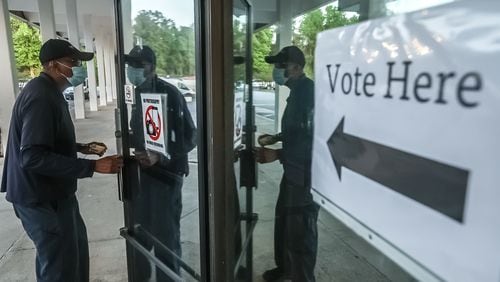This story was originally published by The 19th.
Transgender Americans are at the center of growing political attacks and national media coverage, and yet there is little data — and plenty of misinformation — about their lives.
A report released Wednesday aims to change that.
The National Center for Transgender Equality, a national policy nonprofit, has released a preliminary report summarizing major themes from the upcoming 2022 U.S. Transgender Survey. That full report, which does not yet have an expected release date, will provide the most comprehensive look at life for transgender Americans since the last release in 2015. Researchers plan to release more data in the coming year — including state-by-state reports.
More than 92,000 respondents participated in the latest U.S. Transgender Survey (USTS), which was conducted from October to December 2022. Participants responded to up to 605 questions about their lives, livelihood, health care and sense of safety.
Although federal efforts are underway to capture more data about LGBTQ+ people, such as the evolution of the U.S. Census Bureau’s American Community Survey, the U.S. Transgender Survey remains the only study that captures life for transgender Americans on a massive scale.
“Nobody collects data on transgender people in a formal way,” said Jamison Green, a transgender health expert and writer. “There’s no health tracking. There’s no census data about where we live and who we are and what we experience.”
The first-look data shows that transgender people continue to face steep economic and health disparities while a rash of anti-transgender state laws have caused thousands to flee their homes.
Despite federal employment protections provided by the 2019 Supreme Court case Bostock v. Clayton County, which ruled that it is illegal to discriminate against workers for their gender identity or sexual orientation, economic equality has largely not improved.
Unemployment among trans people has gone up, according to the USTS. Fifteen percent were jobless in 2015. The 2022 report indicates that number is 18 percent.
In 2015, NCTE found that 29 percent of those surveyed were living in poverty. In this latest survey, that number climbed to 34 percent.
Many barriers to health care have also remained or worsened for transgender people. Twenty-six percent of respondents had at least one issue with their insurance company — like being denied coverage for gender-affirming care, or coverage for routine care because they are transgender. In 2015, this number was at 25 percent.
In 2022, 48 percent of respondents who saw a health care provider in the past 12 months had at least one negative experience due to their gender identity — and were refused care, misgendered or experienced harsh treatment. In 2015, 33 percent of respondents said the same.
It is unclear whether the greater sample size in the new survey made any impact on increased rates of discrimination. Sandy James, lead researcher for the survey, said in a statement that his team has not completed the necessary analyses to put those comparisons in context, which they plan to do in future reports.
There are some bright spots in the data. Fewer trans people experienced being verbally or physically attacked in restrooms in 2022 than in 2015, despite a resurgence in bathroom bills. Family acceptance has also apparently remained steady for trans adults, as 60 percent said their immediate family support them.
Most respondents said they are in good health, and the vast majority who have transitioned — 94 percent — reported that they were more satisfied with their lives. Those who took hormone replacement therapy or underwent gender-affirming surgery as part of their transition also reported high life satisfaction.
Gathering this data was important, since so many cisgender people are trying to shape public narratives about trans people and their health care, James said on a press call on Tuesday.
“These data overwhelmingly show that when transgender people are able to live according to their gender identity, they are more satisfied with life,” he said.
As trans people face continuing economic and health disparities, those in states passing anti-trans laws are also faced with a difficult, or even financially impossible choice — whether or not to leave. Across the South, thousands of trans people are moving because of state-level anti-trans laws impacting them.
When data was gathered for the new survey, 10 percent of respondents said they had moved to another area because of discrimination. Five percent of respondents had moved to another state after their own state had considered or passed laws restricting their access to health care, sports or bathrooms.
The top 10 states from which respondents moved, as captured by the survey: Alabama, Arizona, Florida, Georgia, Missouri, North Carolina, Ohio, Tennessee, Texas and Virginia. Those states, minus Virginia, have passed a gender-affirming care ban for trans youth. Not all of these bans are in effect, as various lawsuits work through the courts.
“Nearly half of respondents have considered moving to another state,” said Josie Caballero, director for the U.S. Trans Survey. That so many trans people, as well as their families, are considering leaving their homes highlights the urgency of what they are facing, she said during the press call.
The 2015 survey has been used by Congress, the Supreme Court, law enforcement, medical institutions, universities, social service providers and government agencies. That invaluable data was drawn from more than 27,000 responses.
Since 2015, the country has changed dramatically for LGBTQ+ people. Marriage equality is the law of the land, and is now supported by a majority of Americans. More states across the country have passed nondiscrimination protections. The number of Americans who identify as LGBTQ+ has continued to grow, as has LGBTQ+ representation in the media.
At the same time, political attacks against LGBTQ+ people — especially transgender people — have escalated to unprecedented heights. Hundreds of anti-trans bills have been introduced in statehouses year after year targeting trans participation in sports, access to gender-affirming care, use of public restrooms, representation in books and media and the ability to update identification documents. Most recently, states are pushing to stop legally recognizing trans people in public.
Advocates say that the updated survey is overdue and direly needed as anti-transgender bills flood state legislatures.
Trans people have largely been excluded from state and federal research that is needed to support the creation of policies to protect their well-being. The federal government had never captured any data on LGBTQ+ Americans in one of its large real-time national surveys prior to 2021, when the Census Bureau began asking Americans about their sexual orientation and gender identity in its pulse report on how Americans fared after the onset of the pandemic.
Lawmakers, media and advocates face a persistent drought of information about the needs and experiences of trans people, said Rodrigo Heng-Lehtinen, executive director of the National Center for Transgender Equality. This lack of public understanding, coupled with blatant misinformation, is underpinning these escalating legislative attacks, he said.
“At best, we’re working in a vacuum of information. At worst, we’re combating dangerous misinformation being spread by anti-trans extremists,” he said on Tuesday’s press call.
Green agrees that the absence of updated data has only fueled attacks and misinformation targeting transgender Americans.
“It gave them space to continue to just do that work and opened up a channel for them to just start getting louder and louder about what they believe about us,” he said. “And they are taking over the airwaves.”
Credit: The 19th
Credit: The 19th
MEET OUR PARTNER
Today’s story comes from our partner, The 19th. The 19th is an independent, nonprofit newsroom reporting at the intersection of gender, politics and policy. Visit them online at 19thnews.org or on Instagram @19thnews.
If you have any feedback or questions about our partnerships, you can contact Senior Manager of Partnerships Nicole Williams via email at nicole.williams@ajc.com.








